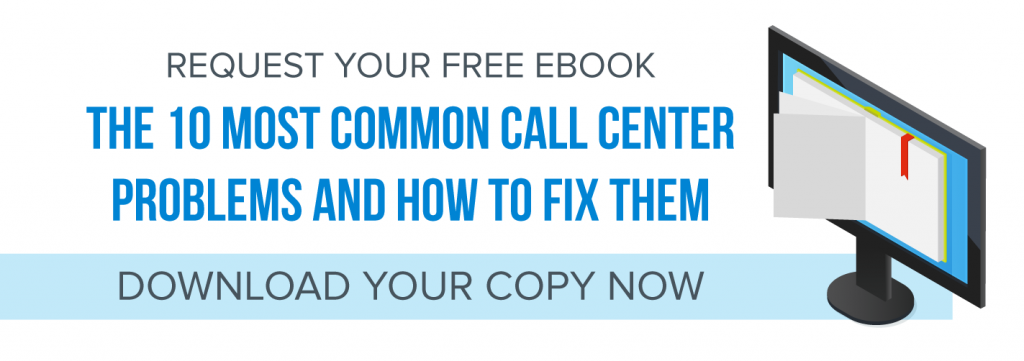Call center attrition is a real problem, but many call centers treat it like a necessary evil. They acknowledge that customer service is a difficult field, and that employees tend to come and go. They understand that employee turnover in the call center industry outstrips most other industries. (It’s between 30 to 45 percent, compared to the U.S. average of 15.1 percent.)
But what can they do about it?
Well, they have to do something, because employee attrition hits where it hurts—the bottom line. Simply hiring a new employee costs time and money. The typical call center will spend around $4,000 for a new hire, and another $4,000 in training costs. And that’s ignoring soft costs—the loss of revenue caused by the absence of an experienced agent, or because you have an experienced agent training a new employee instead of working the phones.
That’s why it’s important to understand what’s driving your employee churn and how to deal with it. Here are a few contributing factors we’ve identified:
#1. Lackluster training
The temptation here is to rush new hires through training so you can put them to work. But that’s a recipe for disaster. You’re about to toss someone into the front lines of customer service. It’s a high-stress job that involves dealing with unhappy customers while using unfamiliar applications and technology. In this kind of environment, a “sink or swim” mentality will lead to a lot of new employees sinking under the pressure and walking off the job.
Training is the most fundamental grounding in company culture that your new hire will receive. If it’s rushed, haphazard, or incomplete, what does that say about you and your business?
Training is also a chance to help the new hire to feel part of the team, which builds an atmosphere of workplace cohesion and collaboration. So don’t let your training program suffer because you’re in a hurry to park someone in front of a phone. Set your new hires up for success and give them the time to train and sharpen their skills.
#2. Better management
Better training shouldn’t be reserved strictly as a solution for employees. What’s sauce for the goose is sauce the gander, meaning management can benefit from better training as well. No one else’s influence will impact call center employees’ performance more than their manager. And management style is often the main reason given when an employee quits.
Managers need to take time out to evaluate their management style and to find ways to improve it. They need to curb any detrimental behaviors in themselves, like a lack of respect for employees or ineffective team management. The most important area of improvement is in a manager’s communication skills. Clear expectations and transparent decisions-making will go a long way in winning an employee’s loyalty.
#3. Limited opportunities for advancement
The employees most likely to stick with your call center and make the biggest difference will usually have a common motivator: personal development. They want to improve their skillset, and they want the opportunity to let those skills shine. Too often, call centers shed their best workers because those employees feel like they’re stagnating. So they leave to continue their schooling, or they turn to other employers where they see more opportunity for personal growth.
In many cases, the problem is simple planning and communicating. Do you have a clearly defined promotion pathway? Are there openings for team leads (or other management positions) or to spearhead special tasks? And once these opportunities are available, do you clearly communicate them to your employees? Let them know what you’re looking for in these positions, and how those positions could help them advance in their careers.
#4. Employee burnout
It happens in call centers—you hear so many complaints, take so much abuse from customers, you get burned out. You can’t take it anymore.
For this situation, we recommend using recognition and rewards to revitalize your team. Workers can undergo tough conditions if they’re properly motivated, and when they know their efforts are appreciated.
Take time out to recognize high-performing employees. Call your other employees together to share the good news when one of them has beaten past records or hit all his or her goals. Or if the employee is on the shy side, take that person aside and thank him or her aside in private.
Additionally, set up a reward system of some kind to incentivize efficiency and excellence. This could include parking spots, extra days off, special privileges—get creative. Go out of your way to surprise your employees and show gratitude for their ongoing efforts.
#5. Substandard technology and tools
Training, skill advancement, and rewards will only take you so far. Employees get frustrated when they’re held back from reaching key metrics because of the limits of the available tools and technology. Unfortunately, call centers have a reputation for outfitting their agents with dated equipment.
A few basic tools your call center requires will stem from your choice of phone system. Cloud-based phone systems offer simple user interfaces that are easy for employees to master, real-time call analytics to track important metrics, and advanced voice features like interactive voice response (IVR), automated call distribution (ACD), call recording, and call monitoring. Cloud phone systems are also more likely to integrate with your other business applications. These integrations cut down on the time your employees spend hunting for relevant customer data across multiple screens and interfaces.
Don’t let call center attrition win.
Not every call center suffers from high turnover rates, but enough do that it’s an industry problem that should be addressed. Improved training for employees and management, opportunities to improve skills, reward programs, and better tools and technology are solid first steps you can take to improve conditions at your call center.
For more fixes to call center problems, download our ebook below.


